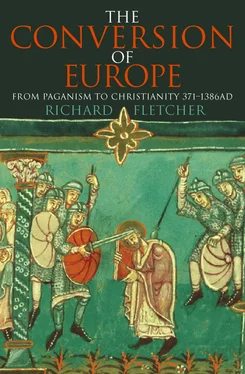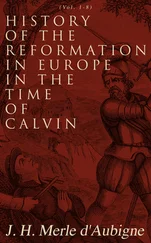Constantinople, Africa, Italy – and other places too: wherever we look, bishops were encouraging the landed elites, the people who commanded local influence, to take firm and if necessary coercive action to make the peasantry Christian – in some sense. Other bishops took matters into their own hands, choosing to take direct and personal action rather than confining themselves to exhortation. The most famous example of such an activist is Martin, bishop of Tours from about 371 until his death in 397.
Martin is a man of whom we can know a fair amount, principally owing to the survival of a body of writings about him by his disciple Sulpicius Severus. Sulpicius was just the sort of man whom Augustine, John Chrysostom and Maximus of Turin were trying to reach and influence. He was a rich, devout landowner with estates in southern Gaul. Inspired by Martin’s ideals Sulpicius founded a Christian community at one of his estates, Primuliacum (unidentified; possibly in the Agenais), and it was there that he composed his Martinian writings. These comprise the Vita Sancti Martini ( Life of the Holy Martin ), composed during its subject’s lifetime, probably in 394–5; three Epistulae ( Letters ) from 397–8; and two Dialogi ( Dialogues ) from 404–6 also devoted to Martin. 5 The Vita was the first work of Latin hagiography to be composed in western Christendom: it displays literary debts to the Vita Antonii by Athanasius and it was in its turn to be enormously influential during the coming centuries as a model of Christian biography. Sulpicius presented Martin as a vir Deo plenus , ‘a man filled with God’. Sulpicius’ Martin was first and last a spiritual force – a man who walked with God, a man set apart by his austerity and asceticism, a monk who was also active in the world as a bishop, fearless in his encounters with evil, endowed with powers beyond the natural and the normal, worthy to be ranked with prophets, apostles, martyrs: a powerhouse of holy energy which crackled across the countryside of Touraine.
One of the features of Sulpicius’ writings about Martin which strikes the reader is their defensive and apologetic tone (to be distinguished from the didacticism common to all hagiography). Martin was a figure of controversy during his lifetime and continued to be controversial after his death. This was in large part because he was in more ways than one an outsider. In the first place he was not a native of Gaul. He was born, probably in 336, at Sabaria in the province of Pannonia (now Szombathely in Hungary, not far from the Austro-Hungarian border) and he was brought up in Italy, at Pavia. He was of undistinguished birth, the child of a soldier. As the son of a veteran Martin was drafted into the army as a young man (351?) and served in it for five years. A convert to Christianity as a child, he was baptized in 354. After obtaining a discharge from the army in 356 he returned to Italy, where he lived for a period as a hermit with a priest for companion on the island of Gallinara off the Ligurian coast to the west of Genoa. Making his way back to Gaul he attached himself to Bishop Hilary of Poitiers, a churchman whose enforced residence in the east between 356 and 360 – exile during the Arian controversy (for which see Chapter 3) – had borne fruit in acquainting him with eastern monastic practices. Martin settled down as a hermit at Ligugé outside Poitiers. His fame as a holy man spread widely in the course of the next decade and in 371 (probably) he was chosen by the Christian community of Tours as their bishop.
2. To illustrate the activities of Martin, Emilian and Samson, from the fourth to the sixth centuries.
Martin’s pre-episcopal career was extremely unconventional. Of obscure origin and mean education, tainted by a career as a common soldier, ill-dressed, unkempt, practising unfamiliar forms of devotion under the patronage of a bishop himself somewhat turbulent and unconventional, the while occupying no regular position in the functioning hierarchy of the church – at every point he contrasted with the average Gallic bishop of his day, who tended to be well heeled, well connected, well read and well groomed. No wonder that the bishops summoned to consecrate Martin to the see of Tours were reluctant to do so. No wonder that Martin did not care to associate with his episcopal colleagues.
This was not the only way in which Martin’s behaviour continued unconventional after he had become a bishop. He refused to sit on an episcopal throne. He rode a donkey, rather than the horse which would have been fitting to a bishop’s dignity. He dressed like a peasant. He founded a monastery at Marmoutier, not far from Tours, where he lived with his disciples, rather than in the bishop’s house next to the cathedral in the city. He was no respecter of persons. He insisted on forcing his way into the house of Count Avitianus in the small hours of the night to plead for the release of some prisoners. When dining with the usurping Emperor Magnus Maximus he was offered the singular honour of sharing the emperor’s goblet of wine; instead of handing it back to Maximus, Martin passed it on to a priest who was accompanying him. His pastoral activities, to which we shall return shortly, were most peculiar. He frequently encountered supernatural beings: the Devil, several times, once masquerading as Christ (but Martin saw through him); angels, demons, St Mary, St Agnes, St Thecla, St Peter and St Paul. He had telepathic powers, could predict the future, could exorcize evil spirits from humans or animals and could raise the dead to life. He worked many miracles and wonders, conscientiously chronicled by Sulpicius Severus. His fame spread widely. He was called over to the region of Sens to deliver a certain district from hailstorms through the agency of his prayers. An Egyptian merchant who was not even a Christian was saved from a storm at sea by calling on ‘the God of Martin’.
Martin may have flouted social convention but it is equally clear from what Sulpicius has to tell us that his network of contacts among the powerful in the Gaul of his day was extensive. He may have behaved boorishly at the emperor’s dinner table, but Maximus showed ‘the deepest respect’ for him, while on a subsequent visit Maximus’ wife sent the servants away and waited upon him with her own hands. The wife of the brutal Count Avitianus asked Martin to bless the flask of oil which she kept for medicinal use. It was the vir praefectorius Auspicius, an exalted official, who invited Martin over to the Senonais to deal with the local hailstorms. It was from the slave of an even grander man, the vir proconsularis Tetradius, that Martin exorcized a demon. Tetradius became a Christian as a result of this wonder. There is some reason to suppose that he went on to build a church on his estate near Trier. (John Chrysostom would have been pleased.) A letter written by Martin was believed to have cured the daughter of the devout aristocrat Arborius from a fever simply by being placed on her body. Arborius was a very exalted man, a nephew of the celebrated poet Ausonius of Bordeaux, who had been the Emperor Gratian’s tutor.
These connections were of significance in the activity to which Martin devoted so much of his energies. Here was a bishop who gave himself wholeheartedly to the task of bringing Christianity to the rural population of Gaul. His methods were violent and confrontational: disruption of pagan cult, demolition of pagan edifices. Here is Chapter 14 of the Vita Martini.
It was somewhere about this time that in the course of this work he performed another miracle at least as great. He had set on fire a very ancient and much-frequented shrine in a certain village and the flames were being driven by the wind against a neighbouring, in fact adjacent house. When Martin noticed this, he climbed speedily to the roof of the house and placed himself in front of the oncoming flames. Then you might have seen an amazing sight – the flames bending back against the force of the wind till it looked like a battle between warring elements. Such were his powers that the fire destroyed only where it was bidden.
Читать дальше












